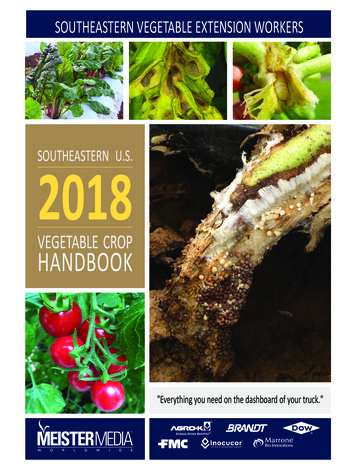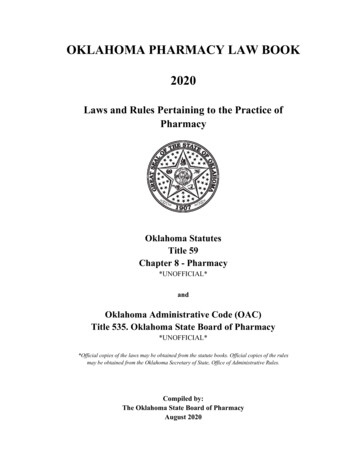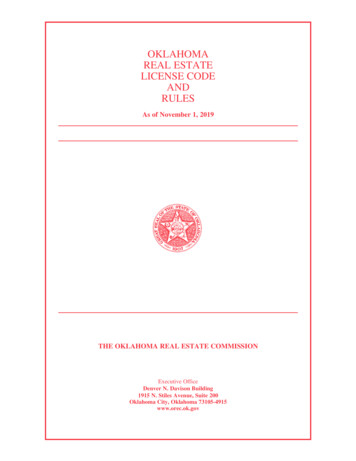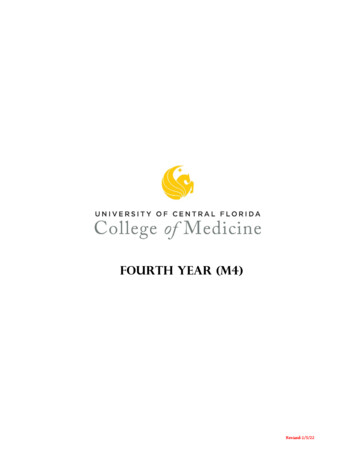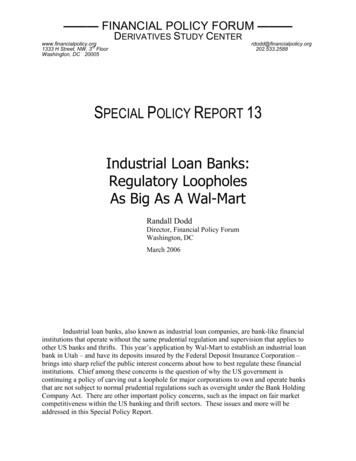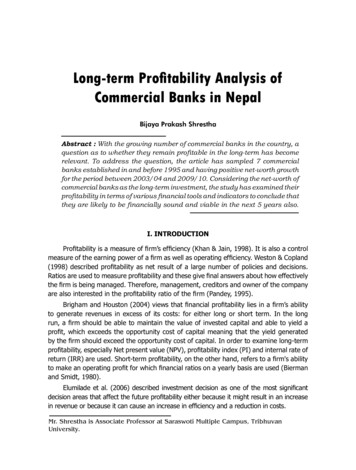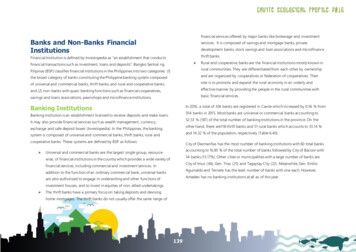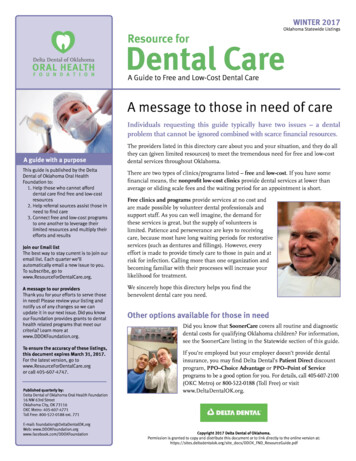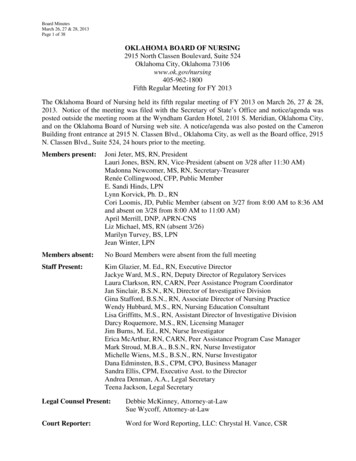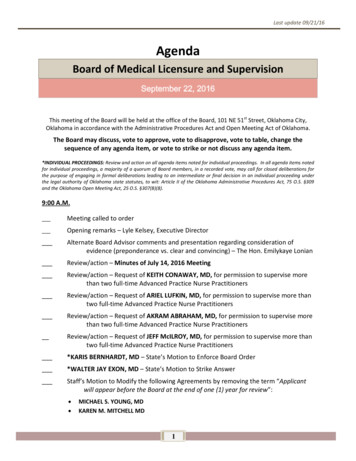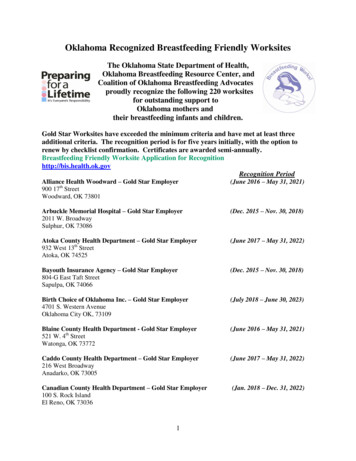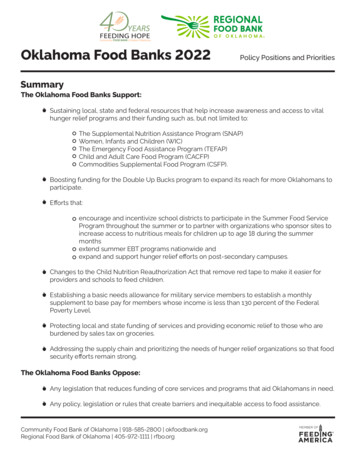
Transcription
Oklahoma Food Banks 2022Policy Positions and PrioritiesSummaryThe Oklahoma Food Banks Support:Sustaining local, state and federal resources that help increase awareness and access to vitalhunger relief programs and their funding such as, but not limited to:The Supplemental Nutrition Assistance Program (SNAP)Women, Infants and Children (WIC)The Emergency Food Assistance Program (TEFAP)Child and Adult Care Food Program (CACFP)Commodities Supplemental Food Program (CSFP).Boosting funding for the Double Up Bucks program to expand its reach for more Oklahomans toparticipate.Efforts that:encourage and incentivize school districts to participate in the Summer Food ServiceProgram throughout the summer or to partner with organizations who sponsor sites toincrease access to nutritious meals for children up to age 18 during the summermonthsextend summer EBT programs nationwide andexpand and support hunger relief efforts on post-secondary campuses.Changes to the Child Nutrition Reauthorization Act that remove red tape to make it easier forproviders and schools to feed children.Establishing a basic needs allowance for military service members to establish a monthlysupplement to base pay for members whose income is less than 130 percent of the FederalPoverty Level.Protecting local and state funding of services and providing economic relief to those who areburdened by sales tax on groceries.Addressing the supply chain and prioritizing the needs of hunger relief organizations so that foodsecurity efforts remain strong.The Oklahoma Food Banks Oppose:Any legislation that reduces funding of core services and programs that aid Oklahomans in need.Any policy, legislation or rules that create barriers and inequitable access to food assistance.Community Food Bank of Oklahoma 918-585-2800 okfoodbank.orgRegional Food Bank of Oklahoma 405-972-1111 rfbo.org
Oklahoma Food Banks 2022Policy Positions and PrioritiesWhere We StandThe Oklahoma Food Banks recognize that Oklahoma has the fifth highest food insecurity rate in the nation.In order to fight hunger and feed hope, we must craft policies that address the root causes of hunger andpoverty in Oklahoma. Economic, food, and health disparities intersect and often magnify one another.Stronger communities exist when people experience financial, health and food stability.We commit to both feeding the line through food distribution that helps those who fall on hard times andultimately shortening the line as we advocate for improved conditions for Oklahoma families to thrive. Ourpositions set a vision for local, state and federal leaders on what is needed to end chronic hunger and putmore Oklahomans on the path to self-sufficiency.Sustain Investment in and Access to Nutritional ProgramsA 2021 U.S. Department of Agriculture report1 found that the number of food insecure Americansremained nearly unchanged between 2019 and 2021. The findings suggest that substantialinvestments in safety net programs like the ones listed below made the difference andcontributed to mitigating hunger during the pandemic. It's critical that we take the lessons learnedand continue investing in our nation's safety net. The Oklahoma Food Banks support sustaininglocal, state and federal resources that help increase awareness and access to vital hunger reliefprograms and their funding such as (but not limited to):The Supplemental Nutrition Assistance Program (SNAP)Women, Infants and Children (WIC)The Emergency Food Assistance Program (TEFAP)Child and Adult Care Food Program (CACFP)Commodities Supplemental Food Program (CSFP)Food Distribution Program on Indian Reservations (FDPIR)Program design also determines accessibility of services. The purpose of our safety net programsis to keep families from falling behind when hard times arise. Reforms are needed at the state andfederal level to help more Oklahomans avoid “the cliff effect” where families on the margins,struggling to make ends meet, lose benefits before they reach stability. An example of the cliffeffect is a modest pay raise triggering disproportionate loss of assistance for working families. TheOklahoma Food Banks support reforms to SNAP and other assistance programs that modernizeprograms to consider current necessities and avoid dramatic loss of services.Community Food Bank of Oklahoma 918-585-2800 okfoodbank.orgRegional Food Bank of Oklahoma 405-972-1111 rfbo.org
Oklahoma Food Banks 2022Policy Positions and PrioritiesExpand Access to Nutritious Foods and Incentivize Healthier ChoicesPrograms like the Supplemental Food Assistance Program (SNAP) provide our greatest defenseagainst hunger. When we invest in SNAP, we’re not just putting food on the table and givingoptions to Oklahomans, we’re growing our workforce and boosting the economy through our localgrocery stores and farmers markets. For every SNAP dollar spent, 1.61 in economic activity isgenerated in our local economy2. For every meal our food banks provide, SNAP provides nine.With the recent modernization of the Thrifty Food Plan, we expect the reach of SNAP to go evenfurther for boosting local economies and keeping food on the table.One area of opportunity in SNAP is incentivizing nutritious food options. A study by the NationalInstitute of Health3 suggests that promoting healthy behaviors requires incentivizing explorationof healthy options of food. The Double Up Bucks program in Oklahoma serves as a great exampleof this type of intervention. SNAP recipients can receive an extra 1 for every dollar spent onqualifying fruits and vegetables when they shop at select, local grocery stores and farmer’smarkets. Participating grocery stores report that not only have they seen an increase in producepurchases, but they’re seeing Oklahomans try diverse fruits and vegetables through the incentive.The program only serves a few areas in the state, but with increased funding, Oklahomans acrossthe state can benefit from this healthy incentive. The Oklahoma Food Banks support boostingfunding for the Double Up Bucks program to expand its reach for more Oklahomans toparticipate.Address Student HungerOklahoma not only has high food insecurity rates among children, it leads the nation as thehighest projected rate of children in very low food security in 20214. USDA defines low foodsecurity as a lack of access to food to the extent that eating patterns were disrupted and foodintake reduced. Because of this, student participation in the Free and Reduced-Price SchoolMeals program is high across our state, with nearly 60% - or almost 400,000 students enrolled.The program serves as a lifeline to ensure that kids can eat breakfast and lunch at school. Hungerextends beyond the K—12 setting. Oklahomans pursing higher education face high rates of foodinsecurity according to surveys by Temple University’s Hope Center5. Malnutrition not onlycreates barriers to learning but affects the physical and mental health of students of any age.The Oklahoma Food Banks support efforts that:encourage and incentivize school districts to participate in the Summer Food ServiceProgram throughout the summer, or to partner with organizations who sponsor sites toincrease access to nutritious meals during the summer monthsextend summer EBT programs nationwide andexpand and support hunger relief efforts on post-secondary campuses.Community Food Bank of Oklahoma 918-585-2800 okfoodbank.orgRegional Food Bank of Oklahoma 405-972-1111 rfbo.org
Oklahoma Food Banks 2022Policy Positions and PrioritiesRemove Barriers for Addressing Child NutritionFederal nutrition programs play a key role in keeping children in Oklahoma fed through schoolmeals, after school programs and summer enrichment. The Child Nutrition Reauthorization Act,which guides child nutrition programs, hasn’t been updated in over a decade. Federal waiversduring the pandemic gave schools, afterschool and summer enrichment providers the neededflexibility to safely and efficiently feed children. It’s time to implement what worked into an updatedChild Nutrition Reauthorization. The Oklahoma Food Banks support changes to the Child NutritionReauthorization Act that remove red tape to make it easier for providers and schools to feedchildren.Boost Tax Credits and Programs that Give Relief to Oklahoma FamiliesOklahoma Food Banks support policies that provide economic relief to vulnerable Oklahomans.Oklahoma is the fifth highest tax state for low-income earners6. This means that low-incomeearners pay a much higher percentage of their income in sales tax than higher-income earners.They spend a larger portion of their income to meet basic needs like purchasing food. As a result,many of our neighbors make the impossible choice between food or essential needs like medicine,car repair and childcare. The Earned Income Tax Credit is an example of tool that helps lift familiesout of poverty. Last session, the Oklahoma Legislature restored the refundability of the OklahomaEarned Income Tax Credit (Oklahoma EITC). When state lawmakers restored the refundability ofthe Oklahoma EITC, it helped put more money back in the pockets of working Oklahomans. Thiseffort was a good start, but more work can be done to give relief to Oklahoma families on the pathto self-sufficiency. The Oklahoma Food Banks support protecting local and state funding ofservices and providing relief to those who are burdened by sales tax on groceries.Alleviate Military HungerFor many active-duty military members, hunger is a reality. With 12 military bases, Oklahoma has astrong military presence. Feeding America estimates that as many as 125,000 active-duty servicemembers and their families face food insecurity in the United States. Challenges like limitedincome of lower ranking service members, high cost of living in certain communities and financialcommitments make them more likely to face hunger. Few active service members qualify forfederal food assistance programs because housing allowances are considered income. Servicemembers often are required to move from base to base, making it difficult for spouses to maintainconsistent work. This can be especially challenging for family members with jobs that requirespecial licensing which differs by state, like teachers, hairdressers or nurses. The Oklahoma FoodBanks support a basic needs allowance for military service members to establish a monthlysupplement to base pay for service members whose income is less than 130 percent of the FederalPoverty Level.Community Food Bank of Oklahoma 918-585-2800 okfoodbank.orgRegional Food Bank of Oklahoma 405-972-1111 rfbo.org
Oklahoma Food Banks 2022Policy Positions and PrioritiesAddress Supply Chain ChallengesThe pandemic has caused industries across the country to face a shortage of supplies andcommodities due to jams in the supply chain. Oklahoma Food Banks feel the impact of the supplychain, too. From the rising cost of food and freight (nearly an extra 25% on food purchases) to theshortage of semi-truck drivers and warehouse workers, these compounding challenges put astrain on our distribution, make accessing food harder, and limit options on food variety. As stateand federal leaders work to alleviate the tension on the supply chain, Oklahoma Food Bankssupport prioritizing the needs of food banks and other hunger relief organizations so that foodsecurity efforts remain strong.Sustain Funding for State BudgetPublic-private partnerships are essential to end hunger in our state. The charitable sector alonecannot alone help families reach stability. The core services our state provides ensure that allOklahomans have the supports needed for a strong quality of life. When cuts are made to criticalprograms or existing funds aren’t linked to inflation rates, we put our vulnerable neighbors at risk.The Oklahoma Food Banks oppose any legislation that disconnect from inflationary trends orreduces funding of core services and programs that aid Oklahomans in need.Equity in Food AccessOklahoma Food Banks believe that every human deserves food security and the dignity to havefoods that meet cultural needs and values. We serve every and all residents in need of foodassistance. When rules and policies are made without the lens of diverse experiences ofOklahomans, we risk worsening hunger in rural areas and among black and brown citizens andimmigrant residents. Past public charge rules serve as a direct example of how policy can createbarriers to food access for groups of people. The rules intended to disincentivize participation inpublic programs of those on the path to citizenship. Instead, it caused confusion on who qualifiesand keeps many people who are eligible to receive food assistance from seeking it out of fear ofdeterring their journey to the American dream. Another factor that plays a role in food insecurity islanguage barriers. As Oklahoma diversifies, language barriers compounded with socioeconomicstatus and education, make linguistically sensitive and cultural strategies necessary in order tocombat food insecurity in our state. With every Oklahoman in mind, The Oklahoma Food Banksoppose any policy, legislation, or rules that create barriers to food assistance.For questions or partnership on our policy positions and priorities, contactBailey Perkins Wright, state advocacy and public policy director,bwright@rfbo.org, 580-483-1600.Community Food Bank of Oklahoma 918-585-2800 okfoodbank.orgRegional Food Bank of Oklahoma 405-972-1111 rfbo.org
Oklahoma Food Banks 2022Policy Positions and PrioritiesSourcesColeman-Jensen et.al., Household Food Security in the United States in 2020. United StatesDepartment of Agriculture Economic Research Service. September ails/?pubid 102075&eType EmailBlastContent&eId db5d3794-c98f-4d8e-9a6e-9e9f58a9ea991Zandi and Yaros. Macroeconomic Impact of Home and Community-Based Service Expansion.Moody’s Analytics. September 20, based-services-expansion.pdf2Shavit et. al., Promoting Healthy Eating Behaviors by Incentivizing Exploration of Healthy Alternatives.National Institute of Health. June 15, 8239191/3Coleman-Jensen et. al. Household Food Security in the United States in 2020. United StatesDepartment of Agriculture Economic Research Service. September /102076/err-298.pdf?v 45144Baker-Smith et. al., #RealCollege 2020: Five Years of Evidence on Campus Basic Needs Insecurity.Temple University Hope Center for College, Community and Justice. February 2020 s/2020/02/2019 RealCollege Survey Report.pdf5Institute on Taxation and Economic Policy, Low Tax for Whom? Oklahoma is a ‘Low Tax State’Overall, But Not for Families Living in Poverty. October 17, -in-poverty/6Community Food Bank of Oklahoma 918-585-2800 okfoodbank.orgRegional Food Bank of Oklahoma 405-972-1111 rfbo.org
The Oklahoma Food Banks Support: . legislation or rules that create barriers and inequitable access to food assistance. Summary Oklahoma Food Banks 2022 Policy Positions and Priorities Community Food Bank of Oklahoma 918-585-2800 okfoodbank.org . provide our greatest defense a
